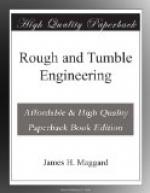Now if you know the circumference of your fly wheel, the number of revolutions your engine is making and the width of belt, you can figure very nearly the amount of power you can supply without slipping your belt. For instance, we will say your fly wheel is 40 inches in diameter or 10.5 feet nearly in circumference and your engine was running 225 revolutions a minute, your belt would be traveling 225 x 10.5 feet = 2362.5 feet or very nearly 2400 ft. and if I inch of belt would transmit 3 H. P. running this speed, a 6 inch belt would transmit 18 H.P., a 7 inch belt, 21 H.P., an 8 inch belt 24 H.P., and so on. With the above as a basis for figuring you can satisfy yourself as to the power you are furnishing. To get the best results a belt wants to sag slightly as it hugs the pulley closer, and will last much longer.
SOMETHING ABOUT SIGHT-FEED LUBRICATORS
All such lubricators feed oil through the drop-nipple by hydrostatic pressure; that is, the water of condensation in the condenser and its pipe being elevated above the oil magazine forces the oil out of the latter by just so much pressure as the column of water is higher than the exit or outlet of oil-nipple. The higher the column of water the more positive will the oil feeds. As soon as the oil drop leaves the nipple it ceases to be actuated by the hydrostatic pressure, and rises through the water in the sight-glass merely by the difference of its specific gravity, as compared with water and then passes off through the ducts provided to the parts to be lubricated.
For stationary engines the double connection is preferable, and should always be connected to the live steam pipe above the throttle. The discharge arm should always be long enough (4 to 6 inches) to insure the oil magazine and condenser from getting too hot, otherwise it will not condense fast enough to give continuous feed of oil. For traction or road engines the single connection is used. These can be connected to live steam pipe or directly to steam chest.
In a general way it may be stated that certain precaution must be taken to insure the satisfactory operation of all sight-feed lubricators. Use only the best of oil, one gallon of which is worth five gallons of cheap stuff and do far better service, as inferior grades not only clog the lubricator but chokes the ducts and blurs the sight-glass, etc., and the refuse of such oil will accumulate in the cylinder sufficiently to cause damage and loss of power, far exceeding the difference in cost of good oil over the cheap grades.
After attaching a lubricator, all valves should be opened wide and live steam blown through the outer vents for a few minutes to insure the openings clean and free. Then follow the usual directions given with all lubricators. Be particular in getting your lubricator attached so it will stand perfectly plum, in order that the drop can pass up through the glass without touching the sides, and keep the drop-nipple clean, be particular to drain in cold weather.




